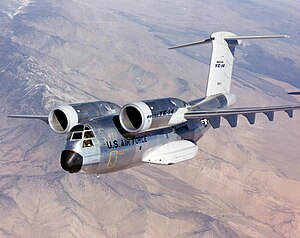Boeing YC-14
| YC-14 | |
|---|---|
 |
|
| One of the two YC-14 prototypes conducting flight testing. | |
| Role | Tactical airlifter |
| Manufacturer | Boeing |
| First flight | 9 August 1976 |
| Status | Retired |
| Primary user | United States Air Force |
| Number built | 2 |
The Boeing YC-14 was a twin-engine short take-off and landing (STOL) tactical military transport aircraft. It was Boeing's entrant into the United States Air Force's Advanced Medium STOL Transport (AMST) competition, which aimed to replace the Lockheed C-130 Hercules as the USAF's standard STOL tactical transport. Although both the YC-14 and the competing McDonnell Douglas YC-15 were successful, neither aircraft entered production. The AMST project was ended in 1979 and replaced by the C-X program.
In mid-1970, the USAF began a paper study, the Tactical Aircraft Investigation (TAI), with Boeing, McDonnell Douglas, and other companies to look at possible tactical transport aircraft designs. This study was a precursor to what became the Advanced Medium STOL Transport program. As a part of this program, Boeing began to look at various high-lift aircraft configurations. Boeing had earlier proposed an underwing externally blown flap solution for their competitor for the Lockheed C-5 Galaxy, and had put this to good use when they modified their losing entry into the Boeing 747. They had also done studies with the original Boeing 707 prototype, the Boeing 367-80, adding extensive leading and trailing edge devices using blown flaps. For the TAI studies, Boeing again looked at those mechanisms, as well as new mechanisms like boundary layer control. However, none of these studied designs were particularly appealing to Boeing.
The Boeing engineers were aware that NASA had carried out a series of "powered lift" studies some time earlier, including both externally blown flaps, as well an upper-surface blowing (USB), an unusual variation. In the USB system, the engine is arranged over the top surface of the wing, blowing over the flaps. When the flaps are lowered, the Coandă effect makes the jet exhaust "stick" to the flaps and bend down toward the ground. They searched for additional research on the concept, and found that half-span upper-surface blowing research had been conducted in the NASA Langley 12-foot (3.7 m) tunnel. An examination of the preliminary results suggested that the system was as effective as any of the other concepts previously studied. Boeing immediately started to build wind-tunnel models to verify the NASA data with layouts more closely matching their own designs. By the end of 1971, several models were being actively studied.
...
Wikipedia
